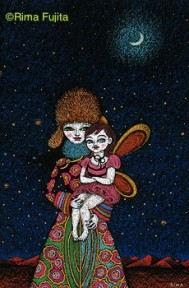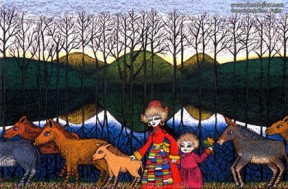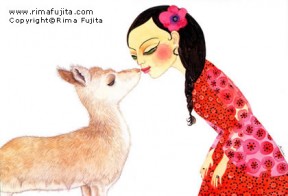 On April 28, internationally acclaimed artist and activist Rima Fujita will present the original drawings of her new book, Save the Himalaya (foreword penned by Richard Ger
On April 28, internationally acclaimed artist and activist Rima Fujita will present the original drawings of her new book, Save the Himalaya (foreword penned by Richard Ger e and HH Dalai Lama) with other recent works at the Sundaram Art Gallery in Beverly Hills. All proceeds will be donated to Tibetan refugee children in exile. Rima’s paintings have the texture of a tapestry woven by a fireside over many years. They have a living warmth, a fairy tale playfulness, a flowing sense of narrative, a moving transcendence and a kind of inevitable serendipity. They inhabit the seasons. The joyous abundance of spring, the powdery chill of winter, the sunshine of summer and something beyond just colour and line and detailing. They have a dimension you cannot put your finger on.
e and HH Dalai Lama) with other recent works at the Sundaram Art Gallery in Beverly Hills. All proceeds will be donated to Tibetan refugee children in exile. Rima’s paintings have the texture of a tapestry woven by a fireside over many years. They have a living warmth, a fairy tale playfulness, a flowing sense of narrative, a moving transcendence and a kind of inevitable serendipity. They inhabit the seasons. The joyous abundance of spring, the powdery chill of winter, the sunshine of summer and something beyond just colour and line and detailing. They have a dimension you cannot put your finger on.
As an only child, Rima Fujita spent a lot of time drawing alone. At 13, she moved from Japan to New York and was not well-conversant with English so spent lots of time (again, as she emphasises! ) in the art studio by herself. “Looking back, art was a tool for me to make friends and communicate with others,” says she. She knew early that she was going to be an artist so she only applied,”to art schools in New York when all other students went to Ivy League universities.”
She adds, “I attended Parsons School of Design in New York for four years.” Now a bit about that mysterious dimension to her work which Rima embraced when destiny opened some strange, new doors to show her that there was a reason why art had chosen her.
In retrospect, she says, “Art to me now is just a tool to serve society, to participate in changing the world and helping others. But when I was in my 20’s, art was a ‘goal.’ I wanted to be be rich and famous! Luckily, I had a great start: solo shows were offered to me, blue-chip galleries wined and dined me. I was at the ‘right’ place with the ‘right’ people in the New York of the 80s.”
But she was not happy. She recalls, “I found a lack of decency amongst the top dealers. I saw a lot of greed, jealousy, competition and arrogance in the art world. I kept questioning myself, “Is this the world I want to be in? What is my purpose here? What am I striving for?” Even though, she did not know what else to do, fate did.
Rima recounts,”One day in 1993, I arrived at JFK after a long flight from Tokyo, with a high fever. Not only was I really sick, but I also did not have any dollars with me. The airport was chaotic and I was just standing there, not knowing what to do. All of a sudden, this tiny woman appeared in front of me, took my hand and handed me some dollars. I said to her, “Thank you, but I cannot accept this. I don’t know you.” She smiled and said, “Please take it. I know that you need it.” I looked at the dollars in my hand, and they were exactly the amount, I needed to get home. How did she know? I wanted to thank her but she was gone. I asked around, but no one had seen her!”
More was to come. Several months later, Rima went to a book shop in SoHo. And suddenly one book fell near her feet even though all the books were neatly stacked in the shelves. She picked it up and began reading. It turned out to be a collection of serendipitous episodes that people had experienced. There was also a story of a woman who had been in trouble at a station, and a man had appeared in front of her, helped her and then disappeared. Rima whispers, “And then, the woman at JFK came back to my mind and tears came rolling down my face. I realized how special that experience had been. And then, just like that my life changed. My art changed.”
It was a story of simple kindness but for Rima, it was a transformative experience. She says, “I learnt from it, the importance of being kind to others at all times, at any scale. It taught me what kind of a person I wanted to be. It taught me what kind of people I wanted to be with. It gave me a new goal – to contribute. It was a revelation. My art and I found a purpose!”
Then appeared a cause that she was destined to be a big part of. Rima recalls, “As a typical Japanese, I did not know anything about Tibet until 1993. In Japan, most of Tibet-related-information is controlled by the media (Japan does not want to upset China), therefore, most Japanese do not know much about Tibet. One night in 1993, I heard a voice in my dream saying to me, “Rima, you must do something for Tibet.” It was almost a command and so I went to the public library on 42nd Street (there was not much Internet access back then) to research Tibet.”
But even after learning about the tragic history of Tibet under the Chinese occupation, Rima did not know how to help. She recalls, “I was just an artist, not rich or famous. “What can I do?,” I kept wondering. Then, I began meeting Tibetans coincidentally but as I knew by now, there are no coincidences in life, right? I became good friends with a few, and one day, one of them said to me, “Rima, at my refugee camp in India, we had nothing. We had no pencils, no note books, no books. We were always hungry and I was always thinking about food.”
And Rima, not usually given to theatrics, exults, “All of a sudden, a thunder of an idea came to me! Oh, my goodness, I should do books! I should create a children’s book for the Tibetan kids. Then, I should print it in the Tibetan language and English, so that they can preserve their dying voice! I should focus on ethnic folktales that were once handed down from generation to generation but are now fading away.”
That was the beginning of Rima’s initiative Books for Children. She shares, “I began with nothing but passion. I had no money, but all the help I needed somehow came my way. People introduced me to supportive people. However, it was not easy. No one knew any folktales. I asked so many Tibetans, but most of them had grown up during such political turmoil that their parents did not have any time or space to tell their kids any folktales. So I wrote to many Tibetan organizations around the world. I sent hundreds of letters asking for folktales. I received only one letter saying, “Sorry we don’t know any.”
 And then one day, Rima ran into a Tibetan monk at some event. “He was rather unfriendly and austere but when I asked him about the folktales, he told me that he knew many! So I went to his monastery/apartment uptown, but he was not there at the appointed time. I waited for three hours at his door step. He finally showed up saying, “Sorry, sorry!” He made some chai for me, we sat down, and he began narrating the folktales. He told me six stories, and they were all great stories of wisdom. I picked one for my book, and named it Wonder Talk after a story where a conflict is resolved without confrontation. I found it very “Tibetan” since Tibetans do not like to confront things but want you to realise your own error. I edited the story, had it translated into Tibetan, illustrated it, and published it.”
And then one day, Rima ran into a Tibetan monk at some event. “He was rather unfriendly and austere but when I asked him about the folktales, he told me that he knew many! So I went to his monastery/apartment uptown, but he was not there at the appointed time. I waited for three hours at his door step. He finally showed up saying, “Sorry, sorry!” He made some chai for me, we sat down, and he began narrating the folktales. He told me six stories, and they were all great stories of wisdom. I picked one for my book, and named it Wonder Talk after a story where a conflict is resolved without confrontation. I found it very “Tibetan” since Tibetans do not like to confront things but want you to realise your own error. I edited the story, had it translated into Tibetan, illustrated it, and published it.”
Rima also raised some funds for the cause, sent 2500 books to 81 Tibetan refugee schools in India, Nepal and Bhutan. This was in 2000 and this book was officially recommended by the UN as an invaluable read. The second book Wonder Garden based on a personal episode in the life of Dalai Lama was created several years later. Now, her newest book Save the Himalaya is on the way. In an interview given to Vogue, Rima recalled her first encounter with the Dalai Lama. And yes, that too happened in a dream. Rima laughs, “I saw that he was being taken away by the Chinese army, and I was running hard to save him! That was how I “met” him first.” She has many stories about him to share but there is still time for that. It has been a miraculous journey for Rima so far and the most beautiful thing is that now she too is assisting life in creating little miracles for those who need them the most.
To be continued…
More about the artist on http://www.rimafujita.com
http://rimafujita.blogspot.com





